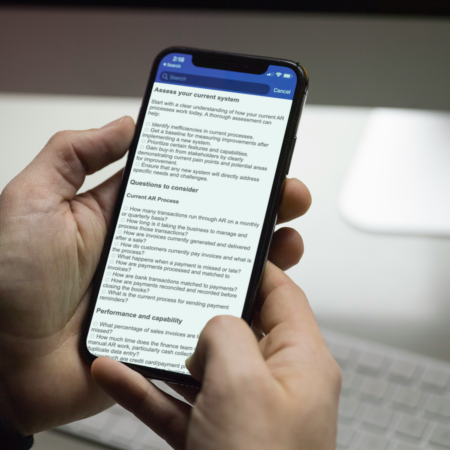
Changing accounting systems can feel intimidating. Even if the legacy accounting system you currently use doesn’t have the features, speed, or power you need, at least it’s familiar.
Sometimes though, the benefits of switching to new software begins to outweigh the cost of learning a new system. If your outdated accounting system can’t keep up with your growth, you want a more robust accounting system, or your vendor no longer supports your needs, it may be time to switch. We’ll help you figure out when it may be time to make a move, what to look for in accounting software, and how to have a successful accounting system migration.
Let’s look into the key points of changing accounting software.
Is It Time for New Accounting Software?
Many small businesses start with a bare-bones accounting system: a free software package plus some Excel spreadsheets, all stored on a laptop. Or perhaps you work at a larger company and “inherited” a system that no longer meets the needs of your growth goals. Either way, it all leads to more of a struggle than it’s worth. Still, the system is familiar, so why change?
In the long run, the efficiency and cost-effectiveness of changing accounting systems often outweighs the expense and inconvenience of sticking with outdated ways. Plus, the advancements in Artificial Intelligence are hard to take advantage of when you’re reliant on Excel or using a multitude of disconnect business tools.
Here are some of the signs it’s time for an accounting system migration.
End Of Software Life Cycle
It makes good sense for vendors to patch and maintain software tools that millions of companies are still using. But when only a small number of customers remain, the software has likely reached its end-of-life date, and the vendor may no longer support it.
You may still be able to use a retiring system for a period of time, but it’s risky—particularly with something as important as your financial information. If antiquated accounting software crashes, you may find yourself holding the bag. Likewise, the vendor may stop releasing patches and updates, allowing criminals to discover and exploit vulnerabilities and compromise your data. It’s vital to switch accounting software before the life cycle comes to a close.
Scaling Up and Improving Performance
Some systems simply don’t scale up well. What worked when your business had a few dozen transactions a week can’t cope now that you’re processing hundreds or thousands of invoices.
Older accounting software is less intuitive and difficult to learn. That may not be a problem for you or your accounting team because you’ve used it for so long but, if your staff is growing, teaching new employees how to enter invoices and expense reports in an older system is time consuming, and training and support may be hard to find.
It may be time to change systems as modern accounting software is better than an older version for a variety of reasons. Generally, newer systems are faster and more intuitive. Most are also cloud-based, so you can enter transactions and obtain information no matter where you are, without having to worry about servers, security, or backups. Also, they offer better functionality such as enhanced automation—saving you time to put towards other uses with a higher ROI.
Lack of Advanced Features
If your current accounting system lacks advanced features like built-in AR and AP automation, AI-powered analysis, or seamless integrations, it may be time to consider an upgrade.
Take a hard look at your current system and the features offered. While it may include some level of automation or AI, these tools might not be robust or scalable enough to support your business’s long-term sustainability and growth.
Modern accounting software offers powerful capabilities to eliminate manual tasks, reduce errors, and free up valuable time for strategic financial planning. For example, automated workflows can streamline processes like invoicing, expense tracking, and reconciliations, while integrations with other business systems ensure data flows effortlessly across platforms. Without these time-saving tools, your team may be stuck in a cycle of inefficiency, unable to focus on initiatives that drive growth and innovation.
What To Look for In Accounting Software
To begin preparing to change accounting systems, clearly identify what you need from a new software tool. For example, what are the biggest issues you are having with your current system? If you’re fed up with its slowness, or how hard it is to create financial statements, ensure you understand how this is addressed in a new system.
Next, decide which features are essential to you in a modern accounting system—and which are nice to have. Is your top desire cloud-based accounting, rich automation capabilities, deep financial reporting, or integration with other applications? You should prioritize what matters most in your search for the right system.
Check out the roadmap to automated accounting →
Cost is a consideration, but keep in mind that maintaining an outdated accounting system has many hidden costs. Factoring in time inefficiencies as well as risks is critical. A faster, automated system can slash hours of workload and lead to dramatic productivity increases.
Key Concerns for New Accounting Software
- Who needs access to the accounts?
- How much access do they need?
- Can the new software scale up as you grow?
- Can you customize the new tool to suit your company’s needs?
- Is it easy to learn?
- Will the vendor provide tutorials or training?
- Does the system deliver the cybersecurity you need?
- Can it integrate with your CRM?
- Does the system offer automation tools for areas such as AR, AP, and bank reconciliations?
- Will I be able to adopt AI tools with this new system?
The Accounting System Migration
Create a timeline that ensures you are fully prepared and can ready your team for the move. Explain why you’re switching accounting software now and demonstrate some ways the change will benefit them. Ensure the team is set up with training and understands expectations for how they will interact with the system.
1. When to Migrate
The advantage of changing accounting systems at the end of a quarter or a year is that you’ll close out temporary accounts and transfer the balances anyway. Why not transfer your data to a new system at the same time? Draw up a chart of accounts, listing the ledger accounts you want in the new system. Depending on the chart’s complexity, you may need fewer accounts than you have now.
2. What to Migrate
Work with your implementation consultant to ensure you have a comprehensive understanding of what data needs to migrate and what you are responsible for. As of your go-live date, you’ll need to import things like open receivables, open payables and, if applicable, inventory balances as well as information for tax authorities, such as 1099 payments. Decide how far back you want to run comparative financials so you can enter ending balances for those periods. Traditionally it’s not advised to bring over transactional detail as it’s very complicated and expensive. One last thought, it may also make sense to maintain one license for your old system for as long as it may take to complete migration.
3. Making the Move
The technical process for an accounting system migration varies depending on the system you select. The practical steps are the same, starting with backing up whatever information you’re moving from your old accounting system. If anything goes wrong, you can fix it as long as you still have the original data on hand.
Review your business process beforehand and understand what systems and information need to connect.
Make a trial run by moving your data into a trial environment on the new system–include a full trial balance and some sample open billings, payables, and inventory. Double check that the figures are what they should be. If everything looks right, you can move full force ahead on migration day. When that date arrives, stop entering new data in the old accounting software until the accounting system migration is complete.
After you’ve transferred the accounts, begin entering data in the new system. Note, some companies elect to enter information in both systems for a couple of days or weeks to ensure the numbers match
Accounting Seed: Salesforce Native
Whatever you may need from a modern accounting system, you’ll find it in Accounting Seed’s cloud-based accounting software platform. Built natively on the Salesforce Platform, it’s easy to use, customizable, and will seamlessly integrate with multiple other financial systems. The app will allow you to automate much of the work you spend countless hours on in the past. If you’re on Salesforce and considering a new accounting system, contact Accounting Seed for a demo and see why it’s the perfect solution for your business.
Read on:
- Your Guide to Accounting Efficiency
- Top 7 Issues Accountants Face Today
- Small Business Accounting Tips
- Startup Accounting Tips: Scaling a Growing Startup
- Accounting Software for Accountants: What to Look For
- DCAA Compliant Accounting Software: What to Look For
- What are the International Accounting Standards (IAS)?
- Top 8 Reasons Why IT Implementations Fail
- What is Cash Disbursement in Accounting?
- Accrued Expenses: What are They and How to Report Them?
- Intro to Accounts Payable and Purchase Order Accounting
- What is Integrated Accounting Software: Everything to Know
- Non-Profit Accounting Software: What to Look For
About Accounting Seed
With over 60,000 users globally, Accounting Seed utilizes the Force.com Platform to seamlessly connect data from sales lead to accounting ledger—providing a complete view of business performance in one system without costly integrations. Want expert advice on the benefits of accounting built directly on Salesforce? Let’s talk.
See Accounting Seed in action
Get a close-up view of how accounting on Salesforce can eliminate the need for costly integrations—and silos of mismatched information—by sharing the same database as your CRM.


